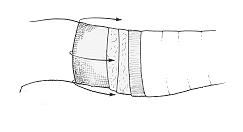A cast consists of stockinette, padding, casting bandages and covering bandages, if necessary.
The protective layer next to the skin is made of stockinette and padding. Once the limb is in the position in which it should be fixed, a tubular knitted fabric called stockinette is put on. It prevents that the following cotton wool bandages slip or cause irritations on the skin. The padding should be thicker in these places where bones are located immediately under the skin, otherwise injuries by virtue of increased pressure occur. > Complications.
It is recommended to wrap paper bandages on the cotton wool to compress the padding. Otherwise the padding will be pressed later when the patient wears the cast and the cast will not fit anymore.
 Stockinette and padding should exceed the planned borders of the cast by 5 to 10cm. After the plaster or fibreglass rolls are wrapped, one trims and folds down padding and stockinette at both ends. It is secured under the last layer of fibreglass or plaster. So padded borders are made. The ilustration shows how the stockinette and padding are folded down below the knee for a short leg cast.
Stockinette and padding should exceed the planned borders of the cast by 5 to 10cm. After the plaster or fibreglass rolls are wrapped, one trims and folds down padding and stockinette at both ends. It is secured under the last layer of fibreglass or plaster. So padded borders are made. The ilustration shows how the stockinette and padding are folded down below the knee for a short leg cast.
The padding is followed by the layer of hard material. Plaster or fibreglass bandages are mainly used. In the case of plaster it is suggested to include longuettes in the cast. These are 4-6 layers of plaster bandages placed on top of each other, which are applied as a splint after dipping in water. They are applied directly to the padding layer or on the first plaster layer. Longuettes reinforce the bandage considerably so that fewer bandages are subsequently required. This makes the cast lighter. When using fibreglass, longuettes are only useful on the soles of walking casts due to the greater load-bearing capacity of the material.
Before putting on both types of bandage, dip them briefly in cold water. The end of the bandage should extend slightly, otherwise it will stick to the rest. After dipping, squeeze out slightly. When applying the bandage, smooth out the layer on each tour so that the layers connect with each other and fit tightly to the limb.
Finally, padding and stockinette are folded down, as mentioned, and secured under the last layer of casting bandage. Before the material is set further corrections can be done.
Especially plaster casts become dirty over time. It is advisable to put a stockinette or a tubular netting on the cast. Both can be easily washed or changed. A tubular netting is also useful for hard bandages that are cut open due to swelling and held together with an elastic bandage. The tubular netting restricts the bandages from slipping or turning over.
Advantages of fibreglass: The bandage is fully load-bearing just one hour after application, whereas a plaster cast is only fully load-bearing after about a day. Fibreglass also has greater breaking strength and long-term resilience. Another advantage is its lower weight. Furthermore fibreglass bandages are available in different colours, which can increase the patient's acceptance of the bandage.
These positive properties of fibreglass however come at the cost of a significantly higher material price. The following disadvantages should also be mentioned: The polymerising material causes allergic reactions on skin contact. It is therefore necessary to wear gloves when applying the cast. The patient's skin is protected by the padding. In contrast to plaster, no corrections can be made to the hardened material. The fibreglass layer is less permeable to air and moisture from the inside. From the outside, the surface is insensitive to water but also rougher and rubs against clothing. Furthermore, unused fibreglass bandages only have a limited lifetime.
What material should be used? In the case of a fracture, a plaster cast is used first as splint or (cut) circular cast. This is because the cast often has to be replaced after a short time due to necessary corrections or after the swelling has disappeared. Later, when the bandage can remain for longer and especially when it can bear weight (walking cast), fibreglass should be used. Alternatively, prefabricated plastic orthoses can also be applied.
The following links will take you to frequently used bandages on the arm and leg. They describe the type of injury for which they are used, how long they should be worn and special features when applying them.